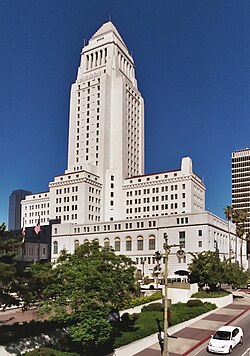
Downtown Los Angeles (DTLA) contains the central business district of Los Angeles. In addition, it contains a diverse residential area of some 85,000 people, and covers 5.84 sq mi (15.1 km2). A 2013 study found that the district is home to over 500,000 jobs. It is also part of Central Los Angeles.
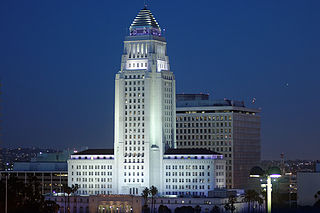
Los Angeles City Hall, completed in 1928, is the center of the government of the city of Los Angeles, California, and houses the mayor's office and the meeting chambers and offices of the Los Angeles City Council. It is located in the Civic Center district of downtown Los Angeles in the city block bounded by Main, Temple, First, and Spring streets, which was the heart of the city's central business district during the 1880s and 1890s.
Bunker Hill is a neighborhood in Los Angeles, California. It is part of Downtown Los Angeles.

Broadway, until 1890 Fort Street, is a thoroughfare in Los Angeles County, California, United States. The portion of Broadway from 3rd to 9th streets, in the Historic Core of Downtown Los Angeles, was the city's main commercial street from the 1910s until World War II, and is the location of the Broadway Theater and Commercial District, the first and largest historic theater district listed on the National Register of Historic Places (NRHP). With twelve movie palaces located along a six-block stretch of Broadway, it is the only large concentration of movie palaces left in the United States.
The Grand Avenue Project was a government lead revitalization effort for the Bunker Hill neighborhood of Downtown Los Angeles on Grand Avenue and centered around Grand Park, its surrounding county government buildings and its parking lots. It was administered by the Grand Avenue Authority, a joint powers authority consisting of Los Angeles County and City. The first task was to improve the streetscape of Grand Avenue. The second element was to upgrade the 12-acre (4.9 ha) Grand Park in 2012 with a refurbished fountains, lawn furniture, walkways and the planting of native gardens. And lastly, constructing several residential buildings, including a two-tower complex on the southeast corner of Grand Avenue and 1st Street, designed by Frank Gehry.
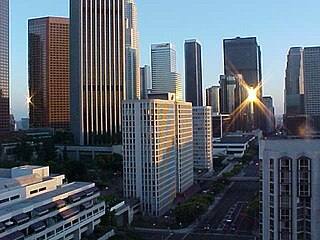
The Financial District is the central business district of Los Angeles along Olive, Grand, Hope, Flower and Figueroa streets from 4th Street to 8th Street. It is south of the Bunker Hill district, west of the Historic Core, north of South Park and east of the Harbor Freeway and Central City West. Like Bunker Hill, the Financial District is home to corporate office skyscrapers, hotels and related services as well as banks, law firms, and real estate companies. However, unlike Bunker Hill which was razed and now consists of buildings constructed since the 1960s, it contains large buildings from the early 20th century, particularly along Seventh Street, once the city's upscale shopping street; the area also attracts visitors as the 7th and Flower area is at the center of the regional Metro rail system and is replete with restaurants, bars, and shopping at two urban malls.

The Regional Connector Transit Project constructed a 1.9-mile (3.1 km) light rail tunnel for the Los Angeles Metro Rail system in Downtown Los Angeles. It connected the A and E lines with the former L Line. The A and E lines previously both terminated at 7th Street/Metro Center station, while the L Line ran through Little Tokyo/Arts District to either Azusa or East Los Angeles. The project provides a one-seat ride into the core of Downtown for passengers on those lines who previously needed to transfer, thus reducing or altogether eliminating many transfers of passengers traveling across the region via Downtown Los Angeles.

Downtown Santa Ana (DTSA), also called Downtown Orange County, is the city center of Santa Ana, the county seat of Orange County, California. It is the institutional center for the city of Santa Ana as well as Orange County, a retail and business hub, and has in recent years developed rapidly as a regional cultural, entertainment, and culinary center for Orange County.
Oakland's Civic Center neighborhood is a residential and public building district on the east side of Oakland's Central Business District. Its borders are roughly Downtown and Harrison Street to the west, the East Lake Neighborhood and Lakeshore Avenue to the east, the Lakeside Apartments District and 14th Street to the North, and Chinatown and 11th Street to the South.

Hill Street is a major north–south thoroughfare in Los Angeles, measuring 4.8 miles (7.7 km) in length. It starts on Martin Luther King, Jr. Boulevard near the campus of USC, and passes north through Downtown Los Angeles, past such landmarks as Pershing Square, the Subway Terminal Building, Angels Flight, Fort Moore and Chinatown. Hill Street merges with the Arroyo Seco Parkway near Dodger Stadium.
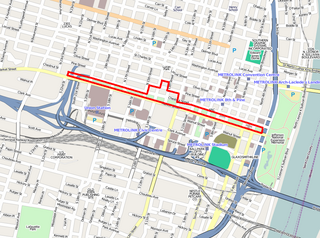
The Gateway Mall in St. Louis, Missouri is an open green space running linearly, one block wide, from the Gateway Arch at Memorial Drive to Union Station at 20th Street. Located in the city's downtown, it runs between Market Street and Chestnut Street.

Grand Avenue is a major north–south thoroughfare in Los Angeles, California. Lined with museums, concert venues, and theaters, this urban center on Bunker Hill attracts millions of people a year. Grand Park stretches between the Los Angeles City Hall and the Los Angeles Music Center on Grand Avenue. In 2007, a $3 billion Grand Avenue Project was proposed to revive Downtown Los Angeles.

Gloria Molina Grand Park, commonly known as Grand Park, is a 12-acre (4.9 ha) park located in the civic center of Los Angeles, California. First developed in 1966 as the 'Civic Center Mall' with plazas, fountains and a Court of Flags, it is now a part of the larger redevelopment known as the Grand Avenue Project, with its first phase having opened in July 2012. Grand Park is part of a joint venture by the city of Los Angeles and Los Angeles County. It was designed and built by the Los-Angeles–based multidisciplinary design firm Rios Clementi Hale Studios. Park programming and entertainment, security and upkeep are maintained by the nearby Los Angeles Music Center.

Kenneth Hahn Hall of Administration, formerly the Los Angeles County Hall of Administration, completed 1960, is the seat of the government of the County of Los Angeles, California, and houses the Los Angeles County Board of Supervisors, meeting chambers, and the offices of several County departments. It is located in the Civic Center district of downtown Los Angeles, encompassing a city block bounded by Grand, Temple, Hill, and Grand Park.

Grand Avenue Arts/Bunker Hill station is an underground light rail station on the A and E lines of the Los Angeles Metro Rail system. The station also has street level stops for the J Line of the Los Angeles Metro Busway system. The station is located under the intersection of 2nd Place and Hope Street, near the Grand Avenue Arts district and in the Bunker Hill neighborhood of Downtown Los Angeles, after which the station is named. In planning documents, the station was originally referred to as 2nd Place/Hope.
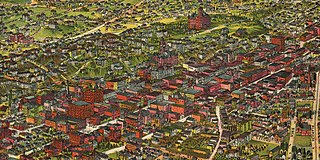
The late-Victorian-era Downtown of Los Angeles in 1880 was centered at the southern end of the Los Angeles Plaza area, and over the next two decades, it extended south and west along Main Street, Spring Street, and Broadway towards Third Street. Most of the 19th-century buildings no longer exist, surviving only in the Plaza area or south of Second Street. The rest were demolished to make way for the Civic Center district with City Hall, numerous courthouses, and other municipal, county, state and federal buildings, and Times Mirror Square. This article covers that area, between the Plaza, 3rd St., Los Angeles St., and Broadway, during the period 1880 through the period of demolition (1920s–1950s).

Retail in Southern California dates back to its first dry goods store that Jonathan Temple opened in 1827 on Calle Principal, when Los Angeles was still a Mexican village. After the American conquest, as the pueblo grew into a small town surpassing 4,000 population in 1860, dry goods stores continued to open, including the forerunners of what would be local chains. Larger retailers moved progressively further south to the 1880s-1890s Central Business District, which was later razed to become the Civic Center. Starting in the mid-1890s, major stores moved ever southward, first onto Broadway around 3rd, then starting in 1905 to Broadway between 4th and 9th, then starting in 1915 westward onto West Seventh Street up to Figueroa. For half a century Broadway and Seventh streets together formed one of America's largest and busiest downtown shopping districts.

The Los Angeles Mall is a small shopping center and series of plazas at the Los Angeles Civic Center, between Main and Los Angeles Streets on the north and south sides of Temple Street, connected by both a pedestrian bridge and a tunnel. It features Joseph Young's sculpture Triforium, a colorful sculpture unveiled in 1975, which has 1,500 blown-glass prisms synchronized to an electronic glass bell carillon. The mall opened in 1974 and includes a four-level parking garage with 2,400 spaces. It stands on the site of what once was some of the oldest commercial blocks in the city that was demolished in the 1940s and 1950s.
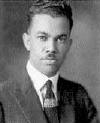
Stanton & Stockwell was a partnership of Jesse Earl Stanton and William Francis Stockwell, two architects active in Southern California during the mid-20th century. Works attributed to them include:
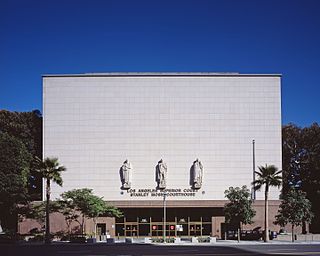
The Stanley Mosk Courthouse is a courthouse in Los Angeles, California home to the Los Angeles County Superior Court. It is located at 110 N. Grand Avenue and 111 N. Hill Street between Temple and First streets, lining Grand Park in the Civic Center in Downtown Los Angeles. The building was constructed in 1958 and has a floor area of 220,860 square feet (20,519 m2) in its west wing and 515,340 square feet (47,877 m2) in the east wing. It has 100 courtrooms, 840 daily workers and 7000 daily visitors. The courthouse is often seen in the TV series Perry Mason, when the title character parks his car on Hill Street to go inside the building.
